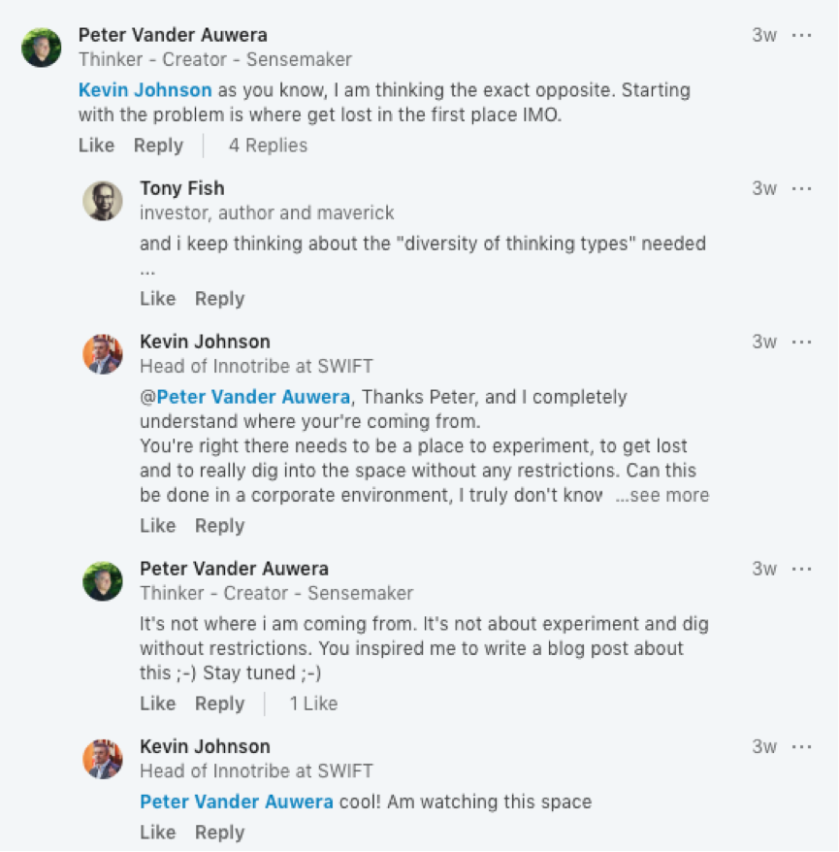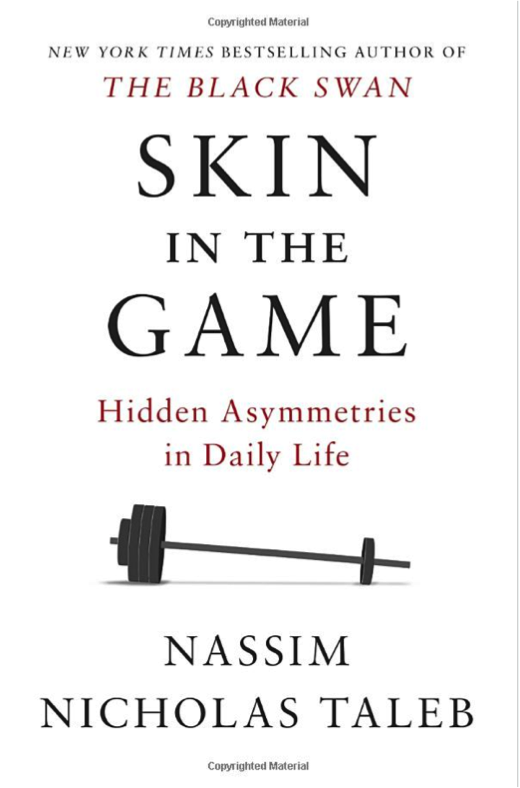
Still life by Song Han
The trigger for this post was an article on the nexxworks site about right & wrong in corporate innovation. The first paragraph focuses on the need to obsess on solving a customer problem. My friend and ex-colleague Kevin commented via LinkedIn:
“Fantastic article! I’ve been banging on for years about starting with the problem, that people care about but this is so much more articulate than me.”
We started a quick exchange on LinkedIn:

The nexxworks article is about much more than problem solving, but problem-solving is what I will be focusing on in this pamphlet/manifesto for creating what you want. As that is where I am coming from.
Not being problem focused seems almost a blasphemy these days. But we don’t realise we have been mis-framed for decades to be problem solvers and solutionists (“there is an app for that”).
It already happens in start-up pitches to start with. Start-ups are coached to pitch in a standard way. It goes back to Guy Kawasaki’s 10 slides to pitch: start with the problem, what is the solution, the team, the business model, etc, etc.
There are the Maddlibs to perfect your one-sentence-pitch. There even are Maddlibs to generate your strategy statement, based on a collection of blah-words (Thx to @swardley).

Everything is “modelled” and vocabulary is standardised: we need MVP’s, lean start-ups, scale-ups, etc. It’s cool, but you then have to explain this new vocabulary to the rest of your troops.
Everything is “role-modelled”. And we get inspired by always the same use cases: Haier, Semco, Apple, Amazon, Uber, etc. We don’t seem to realise that these are exceptions. Only exceptions make the news. The exceptional is normalised, check out hyper-normalisation of Adam Curtis, albeit in another context.
“In the film, Curtis argues that since the 1970s, governments, financiers, and technological utopians have given up on the complex “real world” and built a simple “fake world” that is run by corporations and kept stable by politicians.”
Everything is based on a Silicon Valley solutionist style, a reactive/responsive orientation, something our MBA’s and entre/intra-preneurs and leaders/managers have been trained for at nauseum: define the problem, articulate the solution, make a plan to execute, execute the plan with rigor, and be effective and efficient in doing so.
It may be a style semantic. Ex-Trump-PR-guy Sarramuci said: “you may dislike his (Trump’s) style, but he is very effective.” But one can be very effective at doing the wrong thing. One can be very effective at being a problem solver.
I think it’s more than about style. We have become so politically correct. To please everybody, we say things like “It’s probably a bit of both”. That way, confusion about the real intention creeps in. I say we must be opinionated, and we must be judgemental, we must choose sides.
We say those politically correct things because we don’t have skin in the game. Read Nicholas Taleb’s latest on that subject. For that reason Taleb hates consultants, professors at high schools, some managers and executives, and by extension heads/consultants of innovation. They can say whatever they want, it has no consequences, at least not for their existence or that of the organisation they represent.
I recently heard Nektarios Liolios from Startupbootcamp venting his frustrations on stage, as all the innovation efforts of the last decade have apparently not changed much, or at least not shipped anything substantial. They even start bypassing heads of innovation and innovation teams in general, as they are more and more seen as barriers between customers and the business units. They want to solve real business problems.

Innovation Powerhouse Philips Eindhoven – Architect Janne van Berlo A renovation respecting the building's patrimonial structure.
But I am afraid that a focus on real business problems won’t help. The only way to enable real change and lasting innovation is changing the structure of an organisation.
Structure is about more than reporting lines and P&L units. Structure is about the coherence of narrative, motives, and governance.
- The narrative is about purpose, about patrimony (tacit knowledge), “just-do-it” kind of mantra, action oriented. A narrative is rallying the troops to play the game in a certain way, in a certain context. In war, the game is to win. In business, I would hope it’s about more than winning a finite game, and there is some sense of moral, aesthetical and spiritual advancement, an infinite game across generations.
- Motives are about why we are doing this. There are primary/primal motives like prestige, promotion, reciprocity and tic-for-tac rewards/punishments. Once you add moral, aesthetical, and spiritual advancement, you are driven by second level motivations that have to do with care, tradition, craftsmanship, beauty, proportion, etc. In that sense, I believe that problem solving is a primal motivation. A more advanced intention of creating something great is a second level motivation. So the question should not be “what problem are you trying to solve?” but “what do you truly want to create?” If not, “solving problems” becomes a doctrine, just like “customer first” is a doctrine, or “FNAO”, or “Lean” or “Agile”. Applied across the board without thinking whether it makes sense. Being effective at doing the wrong thing.
- Governance is about how you organise and coordinate high quality flows to play the game in context. This is what real leadership is about. In that sense, innovation is a discipline. And there is nothing wrong with discipline. All great things/products/artworks have been a result of discipline. It is about “getting things done”. Jan Chipchase has an awesome fieldbook and practice for revealing – usually in plain sight – real customer needs. He articulates these needs as “desires on getting things done”. “Getting things done” is something quite different than “solving a problem”.
Artists don’t solve problems. Neither do real innovators. Did the iPhone start with solving a problem? Did Amazon ? Did Facebook? I don’t think so. They started with what they wanted to be, and what they wanted to create. They started with structure, if anywhere at all. But not with the problem.
A customer is IMO not looking for a problem to be solved. A customer is looking for a superior experience.
With that perspective, one could ask “Can organisations change?” to make that happen? Or “Can people change?” and the more critical question, “Why would people change?”

Sheep in boxes - drone photograph by Dean Lewins
The answer again is structure. Change the structure, and change will not be hard, it will be natural.
That’s why the whole idea of the dual approach (separation castle/sandbox, or core/innovation) is flawed. It is the wrong structure.
The preferred structure would probably more resemble a Khasbah or Souks, an open city plan with many innovation cells/areas with maximum transparency for all, so that everybody is inspired and motivated to join those projects too. And “brutal force” (see below).
It’s a paradox of course. Already in 2002, Storey & Salaman said in their Theories about Process of Innovation:
“paradox is at the heart of innovation. The pressing need for survival in the short term requires efficient exploration of current competencies and requires ‘coherence, coordination and stability’; whereas exploration / innovation requires the discovery and development of new competencies and this requires the loosening and replacement of these erstwhile virtues”
Problem-solving is like design thinking: it is fundamentally conservative and preserving the status quo.
“Rational-experimental problem solving begins with a presumption that the search for a solution starts by relying on existing data about the problem. Design thinking, in a slight divergence from the original model, suggests instead that the designer herself should generate information about the problem, by drawing on her experience of the people who will be affected by the design through the empathetic connection that she forges with them”
Remains the question: can it be done in a big or conservative organisation? Yes, of course. And it is done through what I would call the “brutal force attack”. It is the only thing I have seen working in a bigger organisation to actually SHIP innovation into the market and seeing it picked-up by a substantial part of the target customer base.
The brutal force attack requires two things:
- A visionary that is able to articulate in a compelling way what he/she wants to create (and it does NOT start with the problem to be solved). Often this person is somewhat hidden in the fabric/structure of the organisation
- A CxO, usually a CEO with metaphorical balls who will do whatever it takes to make the vision happen. With skin-in-the-game. Even against some part of his/her executive team and/or against part of the Board. His/her position may be at risk. He/she is committed like a pig. (For an omelet with bacon, the chicken is involved, but the pig is committed)
You then build a team to make this happen. A squad of the best of best in your company. And the project lead has a direct red telephone line to the CEO to call in case somebody puts barriers or antibodies to make the vision happen. Usually, it suffices just to threaten to pick up the red phone…
It can be as simple as that: just do it. Just build and ship what you want to create.
If you want to have some romanticised innovation story to go with it, sure, go ahead and organise start-up competitions, create innovation labs, bootcamps, accelerate, incubate, and make a lot of noise and corporate communication about it. Just be aware they are a lot of fun, give a lot of exposure, prestige, and status, but are not needed.
That’s why my mantra is “To inspire other people to dream”. To dream and imagine what they truly want to create.
Like in this Nike promo:
Don’t ask if your dreams are crazy. Ask if they’re crazy enough.
Don’t buy the tyranny of the problem solver. Don’t settle to be a problem solver.
Create what you really want.



Peter,
I really love your point of view!
I’m convinced structure is key as the open theatre to grow the right culture and behaviour to make things happen according to ambitious, vision driven preferred future scenarios.
Peter,
I don’t know of any organization using ‘brutal force attack’ as you describe unless demise is imminent. And even then, 99% is incapable of fundamental, structural change. All companies turn into Nokia’s one day. As you clearly point out, only vision can prevent this from happening.
Can we blame them? For me, it’s like blaming the tiger that he did not foresee that this 3-feet high monkey wandering the savanna on his hind legs would turn into this unrelentless human a couple of million years later, not only to eradicate his habitat but many many more.
Maybe companies need to adopt what biological evolution so smartly does. Abandon tinkering with the individual. Create the next generation. Nobody misses Nokia.
Lieven
Thx for your reaction, Lieven! “Create the next generation” > loving that. Have you trademarked it 😉
Nokia. That terrible company which currently has a $32bln market cap and close to 100,000 employees. The biggest networks company in Europe.
This spoke to me on several levels. We are in the beginnings of our annual budget process and I feel like it will suck all of the wind from our sails. How can you set a budget for the the creative team without remaining iterative? Process and structure can suffocate culture if we’re not careful.
Thx for your feedback. I am not that important that I can suck wind from your sails. I DO agree that process and structure can suffocate culture. Structure for me is the coherence of narrative, motives, and governance. The right structure will not suffocate, on the contrary. You may have an opportunity to increase your budget…
Just excellent. You make clear and explicit so much of what I have gone through during my past life as a management consultant, and I share the conclusions you have come to. One of the main reasons why I have always refused to spell out any prescriptive approach to what I call #wirearchy as an organizing principle for new structures.
I have always imagined that over the course of time as we continue to learn about work and life in networks, #wirearchy as an organizing principle for a networked era would lead to fractals of this (quote below) becoming the structures of peoples’ lives.
<>
Mind you, there’s always surveillance capitalism to worry about 😉
Quote to which I refer:
“The preferred structure would probably more resemble a Khasbah or Souks, an open city plan with many innovation cells/areas with maximum transparency for all, so that everybody is inspired and motivated to join those projects too.”
“” fractals of this (quote below) becoming the structures of peoples’ lives.””
For businesses too. Early examples might be Haier’s Rendanyehi concept.